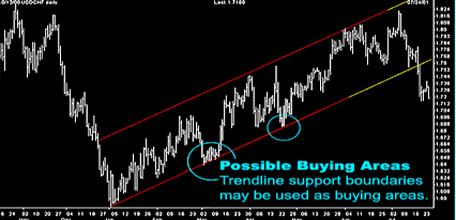Forex Trading Course
The purpose of this e-book is to introduce the Forex market to you. As with many markets, there are many derivatives of the central market such as futures, options and forwards. For the purpose of this book we will only be discussing the main market sometimes referred to as the Spot or Cash market.The word FOREX is derived from Foreign Exchange and is the largest financial market in the world. Unlike many markets, the FX market is open 24 hours per day and has an estimated $1.5 Trillion in turnover every day. This tremendous turnover is more than the combination of all the worlds’ stock markets on any given day. This tends to lead to a very liquid market and thus a desirable market to trade.Unlike many other securities (any financial instrument that can be traded) the FX market does not have a fixed exchange.
It is primarily traded through banks, brokers, dealers, financial institutions and private individuals. Trades are executed through phone and increasingly through the Internet. It is only in the last few years that the smaller investor has been able to gain access to this market. Previously, the large amounts of deposits required precluded the smaller investors. With the advent of the Internet and growing competition it is now easily in the reach of most investors.
You will often hear the term INTER BANK discussed in FX terminology. This originally,as the name implies, was simply banks and large institutions exchanging information about the current rate at which their clients or themselves were prepared to buy or sell a currency. INTER meaning between and Bank meaning deposit taking institutions normally made up of banks, large financial institutions, brokers or even the government.The market has progressed to such a degree that the term inter bank now means anybody who is prepared to buy or sell a currency. It could be two individuals or your local travel agent offering to exchange Euros for US Dollars. You will, however, find that most of the brokers and banks use centralized feeds to insure reliability of quote. The quotes for Bid
(buy) and Offer (sell) will all be from reliable sources.
These quotes are normally made up of the top 300 or so large institutions. This insures that if they place an order on your behalf that the institutions they have placed the order with is capable of fulfilling the order.Now although we have spoken about orders being fulfilled, it is estimated that anywhere from 70%-90% of the FX market is speculative. In other words, the person or institution that bought or sold the currency has no intention of actually taking delivery of the currency. Instead, they were solely speculating on the movement of that particular currency.
When you see FX quotes you will actually see two numbers. The first number is called the bid and the second number is called the offer (sometimes called the ASK). If we use the EUR/USD as an example you might see 0.9950/0.9955 the first number 0.9950 is the bid price and is the price traders are prepared to buy Euros against the USD Dollar. The second number 0.9955 is the offer price and is the price traders are prepared to sell the Euro against the US Dollar. These quotes are sometimes abbreviated to the last two digits of the currency such as 50/55. Each broker has its own convention and some will quote the full number and others will show only the last two. You will also notice that there is a difference between the bid and the offer price and that is called the spread. For the four major currencies the spread is normally 5 give or take a pip (we will explain pips later). To carry on from the symbol conventions and using our previous EUR quote of 0.9950 bid, that means that 1 Euro = 0.9950 US Dollars. In another example if we used the USD/CAD 1.4500 that would mean that 1 US Dollar = 1.4500 Canadian Dollars.
The most common increment of currencies is the PIP. If the EUR/USD moves from 0.9550 to 0.9551 that is one Pip. A pip is the last decimal place of a quotation. The Pip or POINT as it is sometimes referred to depending on context is how we will measure our profit or loss.As each currency has its own value it is necessary to calculate the value of a pip for that particular currency. We also want a constant so we will assume that we want to convert everything to US Dollars. In currencies where the US Dollar is quoted first the calculation would be as follows.
Example JPY rate of 116.73 (notice the JPY only goes to two decimal places, most of the other currencies have four decimal places)
In the case of the JPY 1 pip would be .01 therefore
USD/JPY: (.01 divided by exchange rate = pip value) so .01/116.73=0.0000856 it looks like a big number but later we will discuss lot (contract) size.
USD/CHF: (.0001 divided by exchange rate = pip value) so .0001/1.4840 = 0.0000673
USD/CAD: (.0001 divided by exchange rate = pip value) so .0001/1.5223 = 0.0001522
In the case where the US Dollar is not quoted first and we want to get to the US Dollar value we have to add one more step.
In the case where the US Dollar is not quoted first and we want to get to the US Dollar value we have to add one more step.
EUR/USD: (0.0001 divided by exchange rate = pip value) so .0001/0.9887 = EUR 0.0001011 but we want to get back to US Dollars so we add another little calculation which is EUR X Exchange rate so 0.0001011 X 0.9887 = 0.0000999 when rounded up it would be 0.0001.
GBP/USD: (0.0001 divided by exchange rate = pip value) so 0.0001/1.5506 = GBP 0.0000644 but we want to get back to US Dollars so we add another little calculation which is GBP X Exchange rate so 0.0000644 X 1.5506 = 0.0000998 when rounded up it would be 0.0001.
By this time you might be rolling your eyes back and thinking do I really need to work all this out and the answer is no. Nearly all the brokers you will deal with will work all this out for you. They may have slightly different onventions but it is all done automatically. It is good however for you to know how they work it out. In the next section we will be discussing how these seemingly insignificant amounts can add up.
To read More Please download the book.
ads securities no deposit bonus, book forex, central market, forex bonus without deposit, Forex Broker, forex broker bonus, forex learn, forex learning, Forex Market, forex no deposit bonus, forex no deposit bonus 2016, Forex PDF, Forex Trading Course, hot forex no deposit bonus, INTER BANK, many derivatives, market sometimes referred, no deposit bonus forex, no deposit bonus forex august 2016, no deposit sign up bonus, pdf forex, primarily traded through banks, purpose of this book, such as futures, with many markets
Similar Videos and E-books
LEAVE A COMMENT
All Books
For Beginners
- Candlesticks For Support And Resistance
- Online Trading Courses
- Commodity Futures Trading for Beginners
- Hidden Divergence
- Peaks and Troughs
- Reverse Divergences And Momentum
- Strategy:10
- The NYSE Tick Index And Candlesticks
- Trend Determination
- The Original Turtle Trading Rules
- Introduction to Forex
- The Six Forces of Forex
- Study Book for Successful Foreign Exchange Dealing
- Forex. On-Line Manual for Successful Trading
- 18 Trading Champions Share Their Keys to Top Trading Profits
- The Way to Trade Forex
- The Truth About Fibonacci Trading
- Quick Guide to Forex Trading
- Chart Patterns and Technical Indicators
- Forex Trading
- Trading Forex: What Investors Need to Know
- My Dog Ate My Forex
- Point & Figure for Forex
Forex Market in General
- Screen Information, Trader Activity, and Bid-Ask Spreads in a Limit Order Market
- Strategic experimentation in a dealership market
- Limit Orders, Depth, and Volatility
- Reminiscences of a Stock Operator
- Market Profile Basics
- Quote Setting and Price Formation in an Order Driven Market
- Phantom of the Pits
- An Introduction to Market Profile and a Users Guide to Capital Flow Software
- The Effect of Tick Size on Volatility, Trader Behavior, and Market Quality
- Trading as a Business
- What Moves the Currency Market?
- Macroeconomic Implications of the Beliefs and Behavior of Foreign Exchange Traders
- All About the Foreign Exchange Market in the United States
Psychology of Trading
- A Course in Miracles
- Thoughts on Trading
- Calming The Mind So That Body Can Perform
- Lifestyles of the Rich and Pipped
- The Miracle of Discipline
- Zoom in on Personal Trading Behavior And Profit from It
- The Woodchuck and the Possum
- 25 Rules Of Forex Trading Discipline
- Stop Losses Are For Sissies
- Your Personality and Successful Trading
- Trading as a Business
- The 7 Deadly Sins of Forex (and How to Avoid Them)
- The 5 Steps to Becoming a Trader
Money Management
- Risk Control and Money Management
- Money Management
- Position-sizing Effects on Trader Performance: An experimental analysis
- Fine-Tuning Your Money Management System
- Money Management: Controlling Risk and Capturing Profits
- Money Management Strategies for Serious Traders
- The Truth About Money Management
- Money Management and Risk Management
Forex Strategy
- 1-2-3 System
- Bollinger Bandit Trading Strategy
- Value Area
- The Dynamic Breakout II Strategy
- Ghost Trader Trading Strategy
- King Keltner Trading Strategy
- Scalp Trading Methods
- LSS - An Introduction to the 3-Day Cycle Method
- Market Turns And Continuation Moves With The Tick Index
- The Money Manager Trading Strategy
- Picking Tops And Bottoms With The Tick Index
- The Super Combo Day Trading Strategy
- The Eleven Elliott Wave Patterns
- The Thermostat Trading Strategy
- Intraday trading with the TICK
- Traders Trick Entry
- Fibonacci Trader Journal
- Rapid Forex
- Microtrading the 1 Minute Chart
- BunnyGirl Forex Trading Strategy Rules and FAQ
- The Daily Fozzy Method
- Forex Traders Cheat Sheet
- Offset Trading
- How to Trade Both Trend and Range Markets by Single Strategy?
- A Practical Guide to Technical Indicators; Moving Averages
- FX Wizard
- FX Destroyer
- A Practical Guide to Swing Trading
- Practical Fibonacci Methods for Forex Trading
- Using The Heikin-Ashi Technique
- The Day Trade Forex System
- 5/13/62
- Not So Squeezy Trading Manual
- KobasFX Strategy
- Killer Patterns
- 3D Trading
- 4 Hour MACD Forex Strategy
- WRB Analysis Tutorial
Advanced Forex Trading
- A New Interpretation of Information Rate
- CCI Manual
- Nicktrader and Jeff Explaining Reverse and Regular Divers
- NickTrader on No Price CCI Divergence Trading
- Are Supply and Demand Driving Stock Prices?
- The Sharpe Ratio
- The Interaction Between the Frequency of Market Quotes, Spread and Volatility in Forex
- Trend Determination
- Trend vs. No Trend
- A Six-Part Study Guide to Market Profile
- How George Soros Knows What He Knows
- Core Point and Figure Chart Patterns
- Coders Guru Full Course
- Point and Figure Charting: a Computational Methodology and Trading Rule Performance in the S&P 500 Futures Market
- Evolving Chart Pattern Sensitive Neural Network Based Forex Trading Agents
- Heisenberg Uncertainty Principle and Economic Analogues of Basic Physical Quantities
- The String Prediction Models as an Invariants of Time Series in Forex Market
- Using Recurrent Neural Networks to Forecasting of Forex
- The New Elliott Wave Rule - Achieve Definitive Wave Counts











